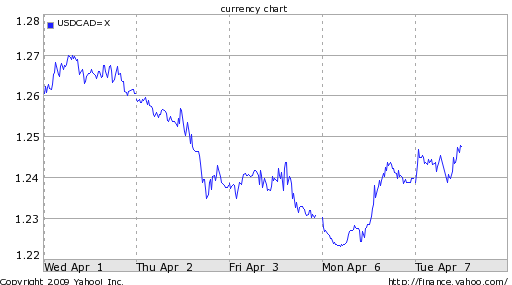April 6th 2009
Canadian Dollar Edges Down on Quantitative Easing Fears
Despite an ebb in risk aversion, the Canadian Dollar is once again falling. Since touching a high of $1.18 in January, the Loonie has zigzagged its way downwards and hovered around $1.25. March 31 marked the end of its third straight quarterly decline.

With the exception of the Japanese Yen (which is declining due to economic factors), virtually every currency has risen against the US Dollar in recent weeks. Stock market rallies have been accompanied by a general pickup in risk tolerance, and investors are piling back into assets and currencies that had been abandoned during the worst of the credit crisis. Why, then, has the Canadian Dollar been excluded from this rally?
Investors cannot be faulted for focusing on the abysmal Canadian economic situation. Employment, public and private spending, and construction – to cite a few indicators – are all falling at alarming speed. As a result, “the nation’s economy, the world’s eighth largest, will shrink at an 8.5 percent annualized pace in the first quarter, the largest decline since at least 1961.” Given that the picture is equally grim throughout the world, however, there must be another explanation.
Cue Mark Carney, head of Canada’s Central Bank, who has announced that Canada will “adopt a much milder version of the U.S. and U.K. strategy of printing more money to fight the recession.” Euphemistically referred to as “quantitative easing,” such a policy involves the injection of cash directly into credit markets and government bond markets, with the dual purpose of creating liquidity and stimulating the economy.
The concern, especially among forex traders, is that printing money will lead to inflation further down the road. When similar policies were announced by the Central Banks of the US, UK, and Switzerland, for example, their currencies plummeted instantly. In the words of one trader, “The precedent is a haircut right off the currency.” The Central Bank of Canada does have a reputation for being conservative, which suggests that it is likely to pursue quantitative easing only as a last step, and in a measured dose.
Accordingly, there is still some bullish sentiment surrounding the Canadian Dollar. One analyst even urges readers to “Consider the Canadian Dollar as a Possible Inflation Hedge,” partly on the basis that “The Loonie is a commodity based currency, so stronger commodity prices mean a stronger Loonie.” Given that crude oil and base metals prices are extremely correlated with the Loonie, this is a fair point.
“Canada’s currency will fall 3.3 percent to C$1.27 to the U.S. dollar by July, from C$1.2298 on April 3, according to the median forecast in a Bloomberg News survey of 40 economists and analysts.” Whether this prediction actually obtains depends primarily on what, if anything, Mark Carney and his colleagues at the Central Bank of Canada decide at their next meeting, scheduled for April 23.



